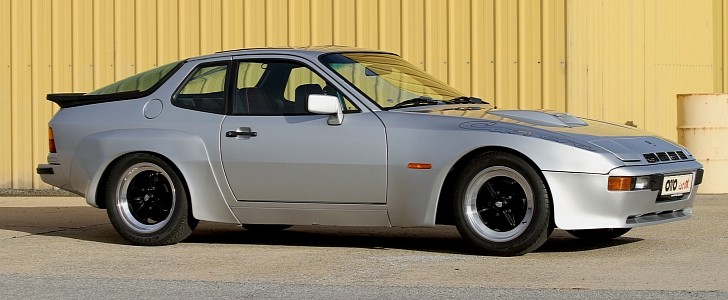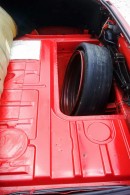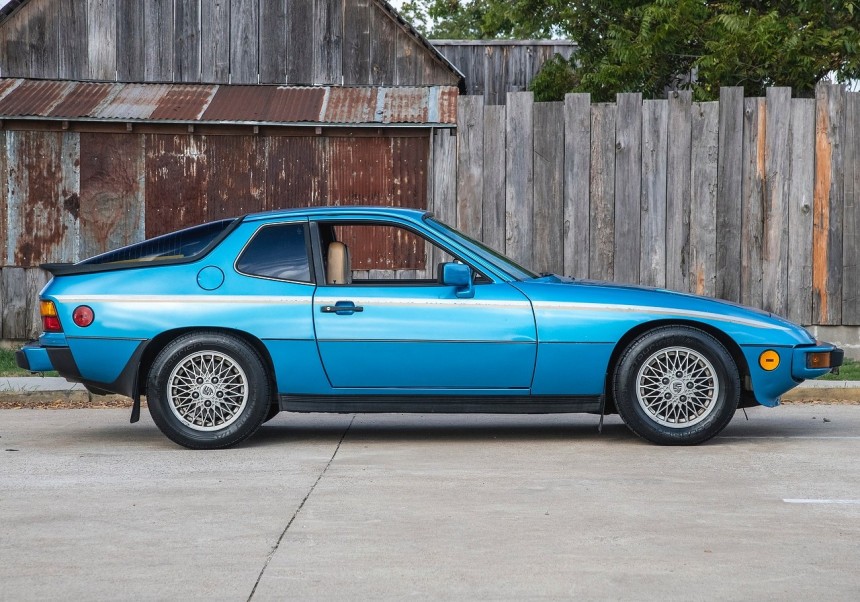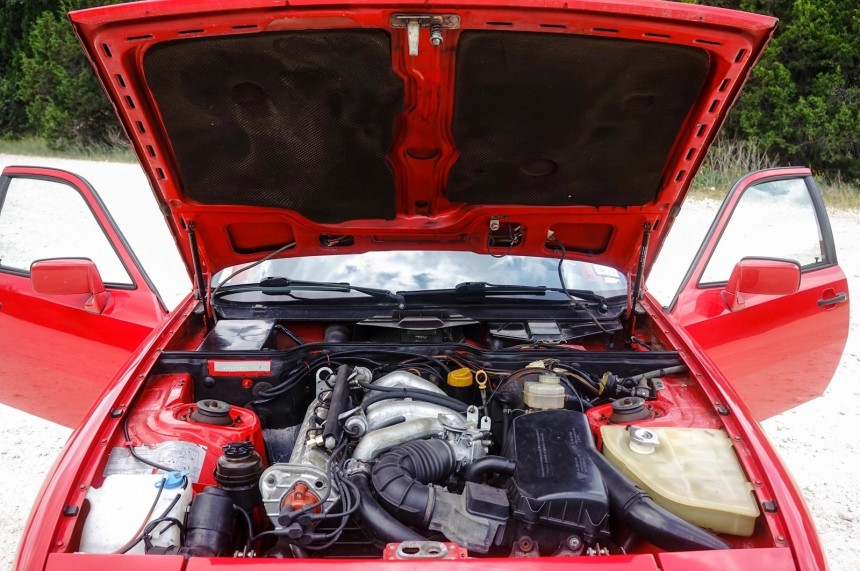The 912 was Porsche’s first entry-level sports car. Essentially a 911 with two fewer cylinders, the rear-engined model was promptly replaced by the 914 midship that features a targa roof and too many rust issues.
Conceived after the V8-powered 928 was approved for production, the 914-replacing 924 was publicly introduced in November 1975 in France at the La Grande Motte marina in Camargue. Series production began shortly thereafter, but instead of Porsche, the peeps at Audi were tasked with making the 924 at their Neckarsulm plant in northern Baden-Wurttemberg.
It’s also worth mentioning that Volkswagen championed the 924. Following the unexpected success of the 914, the Wolfsburg-based automaker commissioned a higher-volume model that would be more practical and easier to live with on a daily basis. Given these requirements, the designers and engineers decided on a front-mounted engine cooled with water/antifreeze instead of air, a 2+2 seating layout, and good ol' rear-wheel drive.
Merely two-and-a-half years after the 924 received the seal of approval from the board of management, the oil crisis and economic issues of the 1970s reared their ugly heads. Volkswagen had to make a difficult choice, deciding on the more affordable, front-wheel-drive Scirocco instead of the 924.
Porsche was much obliged to swoop in and buy the rights to this project. Volkswagen had invested in the ballpark of $50 million by this point, and no fewer than eight prototypes were already up and running. The Stuttgart-based company paid approximately $40 million for the yet-unfinished 924.
Internally referred to as Type 477, the Neunzweivier was cheaper to make than the Neunelfer that defined (and still defines) this marque despite plunging sales during that rather difficult period for the automotive industry. Gifted with unitary construction, the 924 is a little strange compared to regular cars in the sense that the engine is slanted at 40 degrees to keep the hood low. Both manual and automatic transaxles are employed.
This particular setup enabled a low center of gravity and a near-perfect weight distribution, split 53 percent up front and 47 percent over the rear axle. 4,212 millimeters (165.8 inches) long, the 924 is rocking a 2,400-mm (94.5-in) wheelbase that doesn’t allow too much legroom for the rear occupants. In terms of suspension componentry, we’re dealing with a combination of Golf and Beetle parts. The first-gen Golf further donated interior parts, the instrument gauges, and steering rack. The MacPherson struts and semi-trailing arms, meanwhile, have 911 written all over them.
Built less than an hour’s drive from the Porsche headquarters, the 924 originally came with 14- by 5.5-inch steelies, disc brakes for the front wheels, and drums out back. Thanks to Bosch K-Jetronic fuel injection, the VW-Audi engine makes 123 horsepower and 122 pound-feet (165 Nm) of torque. The first Porsche to feature pop-up headlights further boasts two fiberglass aprons, Volkswagen-sourced mirrors, and 911 high-back seats.
Anti-roll bars were optionally available, as were a three-spoke steering wheel à la the 911, rear wiper, headlight washers, and passenger mirror. The 924 also happens to be the first Porsche offered with a conventional torque-converter automatic transmission, namely the 087 three-speed transaxle developed by Volkswagen. The 911’s Sportomatic doesn’t really count because it’s a four-speed manual with a vacuum-operated clutch.
Based on the 905, the Sportomatic doesn’t change gears by itself. Its design requires the driver to change gears by pulling the gear lever to whatever ratio is needed through the H-shaped pattern of the transmission. The first road-going Porsche to feature water-cooled engines, the 924 hits 100 kilometers per hour (62 miles per hour) in a pedestrian nine-odd seconds.
The 924 ended production in July 1985 with 121,289 copies under its belt. During this period, the German automaker improved the breed with a KKK turbocharger that squeezed out 168 horsepower and 245 Nm (181 pound-feet) of torque from the Porsche-developed M31 engine. Not much later on, it was prated to 175 horsepower and 184 pound-feet (250 Nm) of torque.
Merely 13,616 units of the 924 Turbo were delivered. Internally known as Type 937 for left-hand drive and 938 for right-hand drive, the Carrera GT was never offered in the U.S. because it didn’t meet emission regulations.
The M31 engine of the 924 Turbo was updated with an air-to-air intercooler and a larger turbine for the KKK turbocharger, upping the output to 207 ponies and 207 pound-feet (280 Nm). Only 406 units were delivered, along with 44 units of the Carrera GTS and 15 examples of the Carrera GTS CS.
The 370-horsepower Carrera GTR numbers 17 factory-built units. Porsche introduced the 924 S in 1986 with a detuned engine from the 944, then discontinued the naturally-aspirated model in favor of the more modern 944 due to unfavorable exchange rates between the mark and dollar. The 924 was retired in 1988 after a grand total of 152,082 cars were produced.
It’s also worth mentioning that Volkswagen championed the 924. Following the unexpected success of the 914, the Wolfsburg-based automaker commissioned a higher-volume model that would be more practical and easier to live with on a daily basis. Given these requirements, the designers and engineers decided on a front-mounted engine cooled with water/antifreeze instead of air, a 2+2 seating layout, and good ol' rear-wheel drive.
Merely two-and-a-half years after the 924 received the seal of approval from the board of management, the oil crisis and economic issues of the 1970s reared their ugly heads. Volkswagen had to make a difficult choice, deciding on the more affordable, front-wheel-drive Scirocco instead of the 924.
Porsche was much obliged to swoop in and buy the rights to this project. Volkswagen had invested in the ballpark of $50 million by this point, and no fewer than eight prototypes were already up and running. The Stuttgart-based company paid approximately $40 million for the yet-unfinished 924.
This particular setup enabled a low center of gravity and a near-perfect weight distribution, split 53 percent up front and 47 percent over the rear axle. 4,212 millimeters (165.8 inches) long, the 924 is rocking a 2,400-mm (94.5-in) wheelbase that doesn’t allow too much legroom for the rear occupants. In terms of suspension componentry, we’re dealing with a combination of Golf and Beetle parts. The first-gen Golf further donated interior parts, the instrument gauges, and steering rack. The MacPherson struts and semi-trailing arms, meanwhile, have 911 written all over them.
Built less than an hour’s drive from the Porsche headquarters, the 924 originally came with 14- by 5.5-inch steelies, disc brakes for the front wheels, and drums out back. Thanks to Bosch K-Jetronic fuel injection, the VW-Audi engine makes 123 horsepower and 122 pound-feet (165 Nm) of torque. The first Porsche to feature pop-up headlights further boasts two fiberglass aprons, Volkswagen-sourced mirrors, and 911 high-back seats.
Anti-roll bars were optionally available, as were a three-spoke steering wheel à la the 911, rear wiper, headlight washers, and passenger mirror. The 924 also happens to be the first Porsche offered with a conventional torque-converter automatic transmission, namely the 087 three-speed transaxle developed by Volkswagen. The 911’s Sportomatic doesn’t really count because it’s a four-speed manual with a vacuum-operated clutch.
Based on the 905, the Sportomatic doesn’t change gears by itself. Its design requires the driver to change gears by pulling the gear lever to whatever ratio is needed through the H-shaped pattern of the transmission. The first road-going Porsche to feature water-cooled engines, the 924 hits 100 kilometers per hour (62 miles per hour) in a pedestrian nine-odd seconds.
Merely 13,616 units of the 924 Turbo were delivered. Internally known as Type 937 for left-hand drive and 938 for right-hand drive, the Carrera GT was never offered in the U.S. because it didn’t meet emission regulations.
The M31 engine of the 924 Turbo was updated with an air-to-air intercooler and a larger turbine for the KKK turbocharger, upping the output to 207 ponies and 207 pound-feet (280 Nm). Only 406 units were delivered, along with 44 units of the Carrera GTS and 15 examples of the Carrera GTS CS.
The 370-horsepower Carrera GTR numbers 17 factory-built units. Porsche introduced the 924 S in 1986 with a detuned engine from the 944, then discontinued the naturally-aspirated model in favor of the more modern 944 due to unfavorable exchange rates between the mark and dollar. The 924 was retired in 1988 after a grand total of 152,082 cars were produced.






































